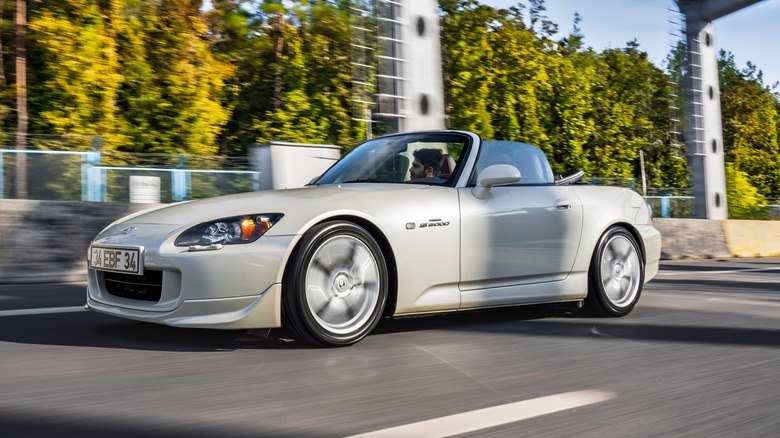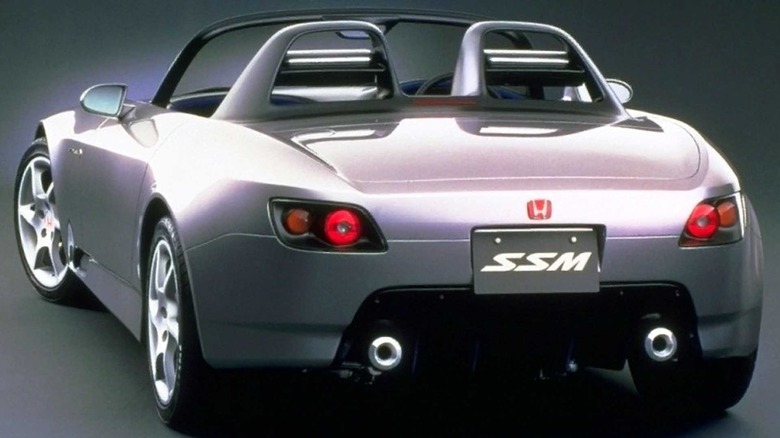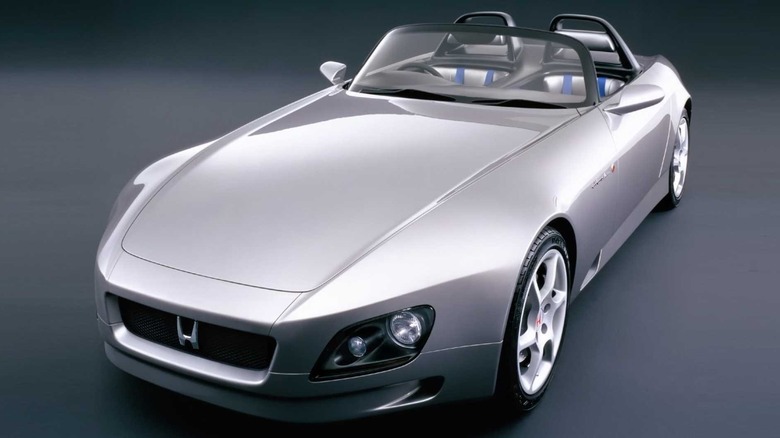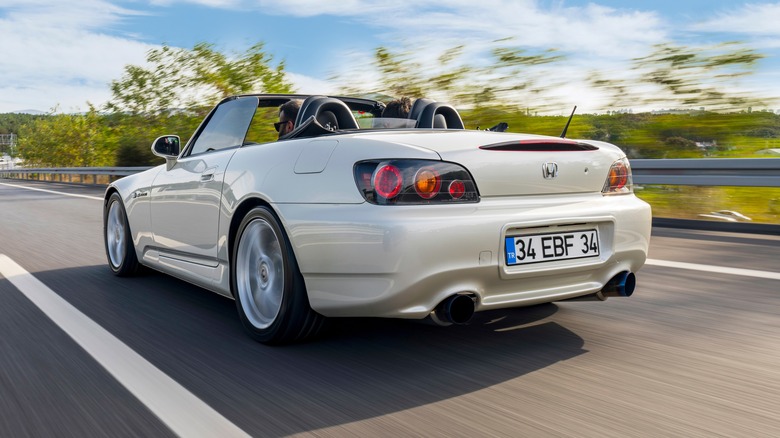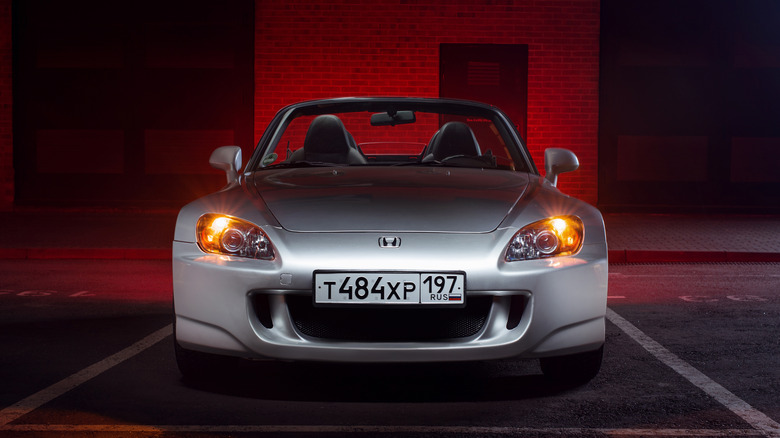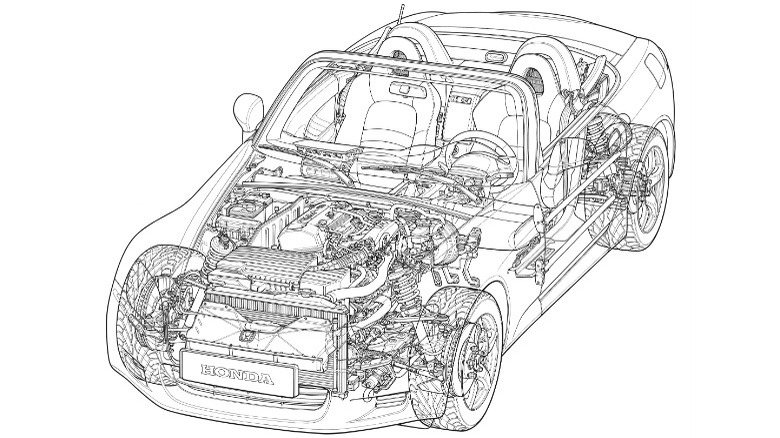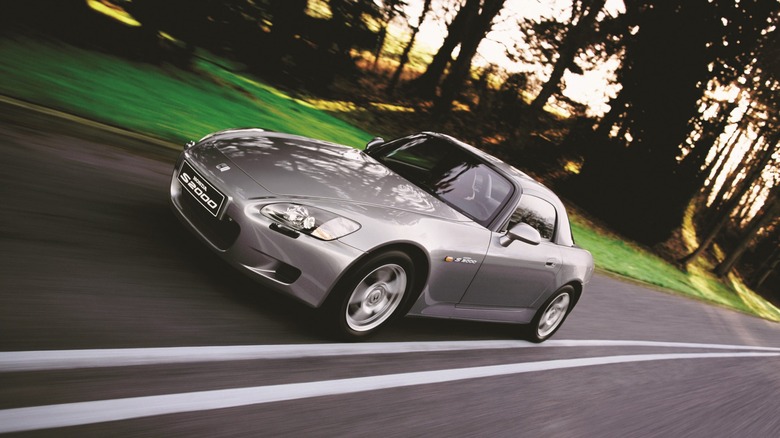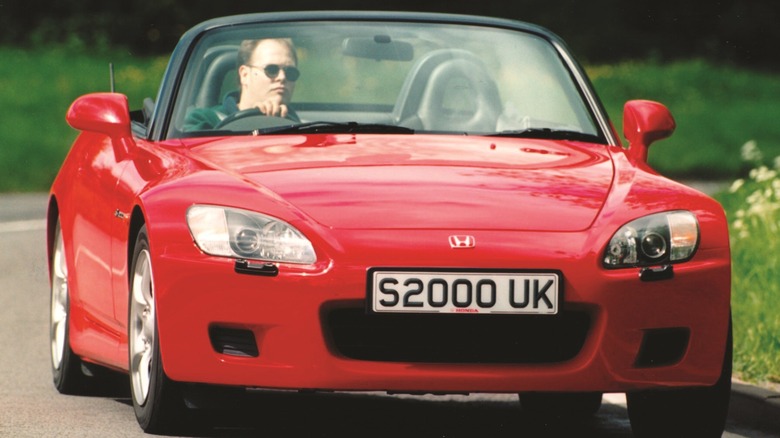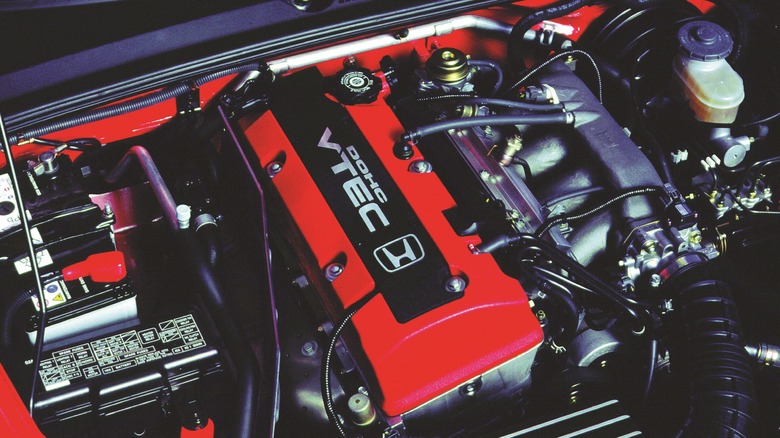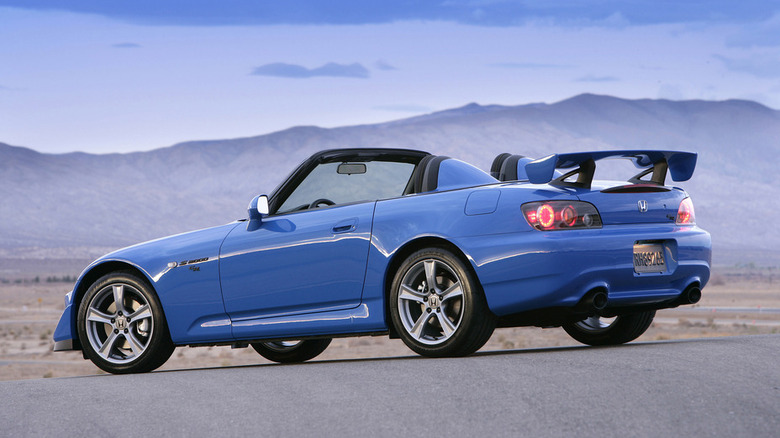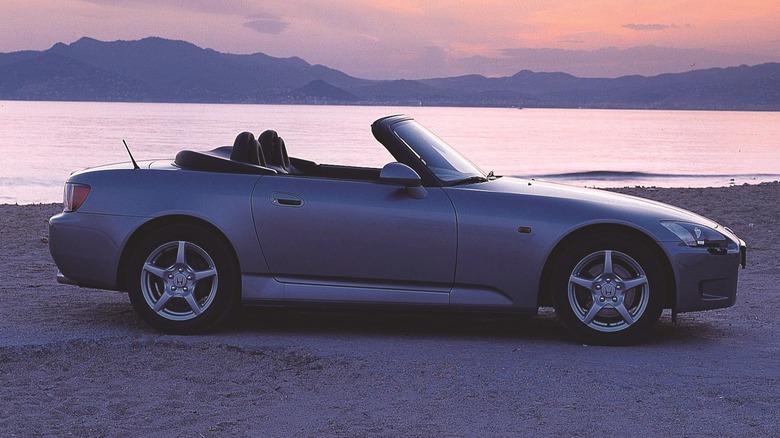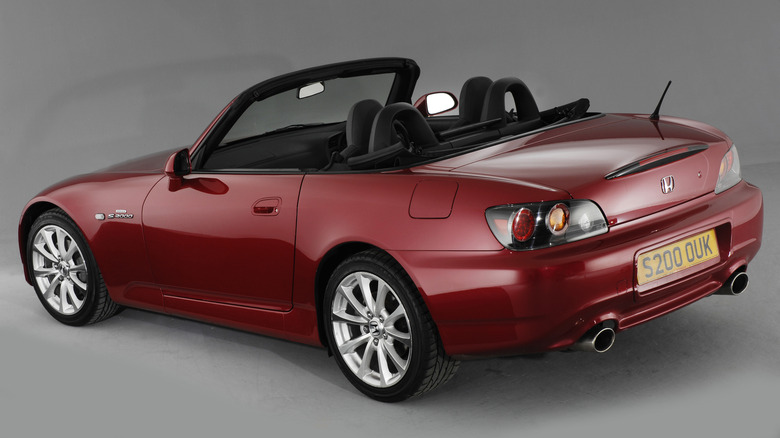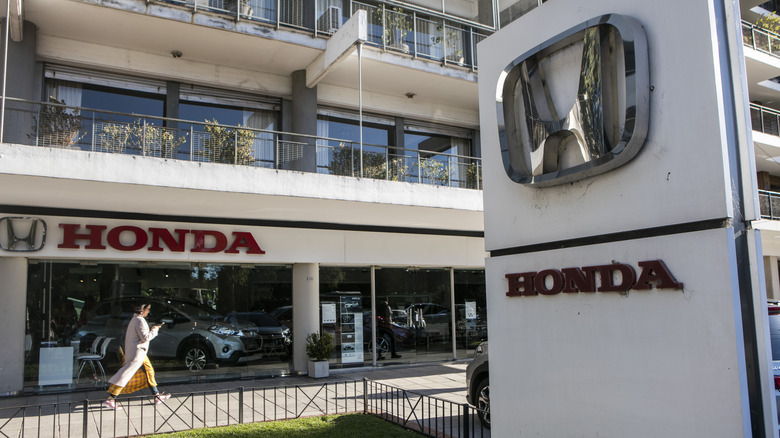12 Things You Should Know Before Buying A Honda S2000
It's a claim often repeated by enthusiasts and, with the industry switching to electrification, arguably more true than ever before: "They don't make cars like they used to." It's also very true in the case of the Honda S2000, which mixed sharp handling with an eager, high-revving engine to create an intoxicating formula that no one has managed to replicate since. However, it wasn't always an icon. When it first debuted, the car had plenty of critics, most of whom focused their ire on it's lack of torque relative to many of its contemporaries.
Indeed, on paper, the S2000 looks good but not great, with relatively modest specs and a high asking price both at the time and in today's used market. So what is it that made the car stand out from its peers in a way that's ensured it remains a collectors' favorite over a decade since production ended? There's no simple answer to that question, but perhaps the best way to answer it is to experience one. For anyone looking to get their hands on Honda's engineering marvel, here's a quick rundown of the car's history, and what to look for when you're on the hunt for a bargain-priced used example.
Launched to celebrate Honda's 50th anniversary
Unveiled in production form at the Tokyo Motor Show in 1998, the Honda S2000 marked the return of the "S" line of lightweight sports cars. Its predecessor, the S800, had originally gone out of production in 1970. As a way to celebrate the company's 50th anniversary as a manufacturer, Honda decided to build a contemporary version of that classic model. It wasn't the first time that Honda had shown off the S2000 design — a similar concept called the SSM (Sport Study Model) had already debuted at the same show three years earlier.
However, the SSM concept was just that — only a concept, and one that many expected would never make production. It came as something of a surprise when the production car was unveiled sporting a similar design and equally high-revving engine, although there were a few key differences between the two. The SSM had an inline-5 engine, while the production S2000 had a more conventional inline-4. The NSX-derived five-speed auto 'box from the concept had also been swapped out for a six-speed manual transmission, although that turned out to be very much to the benefit of enthusiasts.
It was partially styled by Pininfarina
While Honda has gained a well-earned reputation for reliability, practicality, and excellent handling for its enthusiast models, styling hasn't always been the brand's strong point. Its designs have traditionally tended to border on the conservative side, and on the rare occasion Honda's designers have been given the green light to go wild, the results haven't always been stellar. The FK8 Civic Type R, for example, looked like it was trying too hard, giving a slightly "hooligan" look to what was otherwise a very accomplished hot hatch.
The S2000, in comparison, has aged excellently, with a timeless design that compliments the roadster's evergreen enthusiast appeal. Part of that design can be credited to Italian design powerhouse Pininfarina, who worked closely with Honda's designers to pen the original SSM concept. The design was later fine-tuned by Daisuki Sawai, an in-house Honda designer, before going on sale. But crucially, all the key proportions remained the same.
It wasn't universally well received at first
While today it's widely considered to be one of the best Hondas ever made, the S2000 had plenty of critics when it first launched. This criticism tended to be focused on one of two things: the car's perceived lack of torque and its twitchiness in wet or slippery conditions. The torque issue is one that's hard to argue with at lower speeds, especially when comparing the S2000 to many modern sports cars. There simply isn't the lower-end grunt that drivers might expect, with overtaking often requiring some advance planning.
That all changes when the engine gets into the higher parts of its rev range, but it's only under limited circumstances where that's possible. Drive the car in heavy traffic or low-speed urban areas and you'll miss out on the best part of S2000 ownership, so buyers looking for a sporty daily driver that'll make the morning commute more fun should probably look elsewhere. The twitchiness issue can also make the car a hassle for everyday driving, although some examples will suffer more than others.
AP1 cars are twitchier than AP2 cars
In response to customer feedback regarding the S2000's tendency to snap oversteer, Honda softened the suspension on later models, and added a traction control system. Pre-facelift (AP1) cars are generally more sensitive to the issue, while later (AP2) models are easier to control for less experienced drivers. AP2 models are also the way to go for anyone looking to do a significant portion of their yearly mileage on busier roads since they tend to be more forgiving and the larger 2.2L engine provides a little more low-end torque.
That said, it's not like the S2000 is something that first-time sports car drivers should be afraid of. As long as you're careful and stay aware of the car's limitations, the general consensus among S2000 owners seems to be that it's a relatively easy car to get used to driving, facelift or not. Like any other sports car, just make sure your confidence doesn't exceed your driving abilities.
Near-perfect weight distribution
Despite its handling imperfections in some respects, the S2000 remains one of the sharpest and most involving cars of its era to drive, and part of that is down to its excellent weight distribution. The car utilized an "x-bone" frame design, which was both lightweight and rigid. But, perhaps most importantly, it allowed the engine to be positioned behind the front wheels, helping to keep weight distribution as close to perfect as possible.
Although "50:50" is often used as a catch-all term for optimal weight distribution (including in Honda's own promotional material for the S2000), it's perhaps an oversimplification of what makes the car handle so well. Keeping the car's mass as centrally distributed as possible, as well as being evenly distributed between each half, is in fact the key to optimal handling. The car's front-mid engine layout, along with the central position of the driver, means that most of the car's mass is distributed in the middle of the car. That gives it an inherent handling advantage over traditional front-engined roadsters, which included several of its key rivals at the time.
The engine is best at high revs
While its handling is impressive, it's the S2000's engine that's primarily the reason enthusiasts fell so in love with it. As previously mentioned, it's not always easy to get the best out of the engine, as it really starts to come alive above 5,000 rpm. Peak torque arrives at 7,500 rpm (153 lb-ft, in case you're wondering), and the redline sits way up at 8,800 rpm. Push it even further and the rev limiter kicks in at 9,000 rpm.
Those figures were practically unheard for a sports car of its day, and even today they remain highly impressive. The engine boasted the highest power per liter of any naturally aspirated production engine at launch, with numbers more similar to that of a racing engine than any road car. With such groundbreaking numbers, you might expect the inline-4 to be unreliable, but that's not at all the case. As long as they've been properly maintained, even higher mileage S2000s should have plenty of life left in them thanks to Honda's legendary build quality.
Over 110,000 units were sold
The S2000 was a commercial success, and the company reports that it sold over 110,000 units globally between 1999 and 2009. CarSalesBase estimates that over 66,000 of those were sold in the U.S., with many of those cars still on the road today. That means there's plenty of choices when it comes to used examples, so finding one in good condition shouldn't be much of a challenge.
As with any used car, be aware of any suspicious sounds on a test drive, particularly if you hear a rattle on startup. This could indicate that the timing chain tensioner needs replacing, which is not a particularly expensive task but can cause serious issues if not rectified quickly. Rust is also a perennial problem on older cars, and the S2000 is no exception. In particular, inspect the underside on older S2000s, along with the rear wheel arches, as they're known points of weakness thanks to Honda's lack of rust protection.
Keep an eye on the oil level
Another key thing to watch out for is the S2000's oil level, as any evidence from previous owners that the car's fluids haven't been properly maintained is a definite cause for concern. Honda's roadster is known for being particularly thirsty for oil, with top-ups and changes needed much more regularly than with many other sports cars. Honda's manual recommends a full oil change every 7,500 miles, but it's better to err on the side of caution and change it closer to 6,000 miles.
Frequent track or otherwise intensive use will exacerbate the issue, so a full change might be required every 4,000 miles at most. Check with the owner that their maintenance schedule is suitably frequent, as if it isn't, it's probably best to avoid buying the car. It's not worth taking the risk of having hidden problems that could cost a fortune to fix later down the line.
The Club Racer improved the formula even further
If the standard S2000 isn't rare or lightweight enough, Honda also offered the upgraded Club Racer during the car's later years of production. With its wilder body kit, wider tires, and stiffened suspension, the CR was the variant to have if track days were your main concern. It was also slightly lighter than the regular car, but at the expense of losing the folding soft top, air-con, and radio. None of these are even remotely important when you're hunting apexes on a circuit.
They are, however, more desirable for anyone who wants to drive their car on the road on a regular basis, and as a result, the Club Racer only sold in small numbers. If you'd like to get your hands on one today, be prepared to spend a long time browsing the classifieds for an example in good condition, and then pay a significant premium for the privilege. Data from Classic shows an average sale price of $65,250, with the lowest-mileage examples selling for more than $100,000.
Buying one won't be cheap
Thankfully, buying a regular S2000 won't cost anywhere near that much, but it still won't be cheap. Classic data shows an average price of $35,872 across AP1 and AP2 models, with later-model AP2s commanding a premium over pre-facelift cars. There are still some bargains to be found on the market, but it'll be difficult to find a decent example for less than $20,000. At the other extreme end of the market, an as-new 2000 model-year car with just 38 miles on the clock sold for $80,000 in July 2022, setting a record for the highest price for a stock AP1 to date.
Prices have steadily risen over the past few years, which is good news for owners and bad news for those looking to buy one for the first time. As time goes on and supply starts to dry up, expect prices to continue rising.
A successor has been rumored for years
Every once in a while, the rumor mill turns that a successor to the S2000 is on the way, but to date, nothing has surfaced. In 2015, SlashGear reported on one such rumor that suggested a third generation of the car was in development, with Honda's engineers even flying out to England to meet members of an S2000 owner's club. Whether the project was canned or was never in development at all, was never officially confirmed. Either way, enthusiasts have been left empty-handed.
More recently, Forbes reported that a new car would be launched in 2024 to coincide with the S2000's 25th anniversary, citing "a source close to Honda." The new car would reportedly remain similar in proportions to the existing model, but employ a version of the Civic Type R's four-cylinder engine with up to 350 horsepower on tap. That article was published in 2020; since then, nothing more has come from the claims. Although of course, there is still time.
Honda's priorities have shifted
While there's still a chance that Honda might be planning a new S2000 for 2024, it seems unlikely. The Japanese manufacturer has been hit hard by the ongoing semiconductor shortage, forcing it to reduce output targets for 2022, and with supply chain issues expected throughout 2023. Honda is having a hard enough time trying to keep up with the demand for models it already makes, so adding another new model is probably not high up on its list of priorities. Plus, every major automaker is investing billions into the shift towards electrification, leaving little room for investment into new internal combustion cars.
With stringent new emissions laws and bans on the sale of gas-powered cars imminent in major markets like Europe and China, a new internal-combustion S2000 might not have long to live before it's forced out of dealerships. In summary, it's increasingly likely that the original S2000 really is the last of its kind, a final swan song for Honda's legendary line of roadsters.
